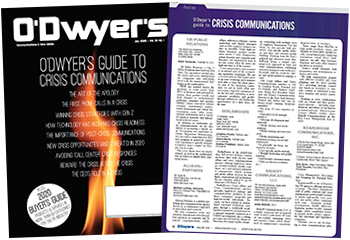 Alex Stanton Alex Stanton |
Organizations responding to a crisis too often end up employing an approach like what many of us have experienced when interacting with a customer call center on a problem or complaint. You get a morass of contradictory information from someone who lacks authority, a refusal to accept responsibility and no feasible solution to your problem.
The reason this strategy underperforms in a call center interaction is the same reason it falls short in a crisis situation: the focus is on rapid, uniform response, not on providing what’s necessary: thoughtful, nuanced responses tailored to the needs and motivations of specific audiences. As much as people want immediate answers in the wake of a crisis, they understand that the world is a complicated place, and not everything is black or white. What they want most is to be heard and treated with respect, to get a response that’s honest and authentic. And sometimes people just want to hear the facts so they can judge for themselves.
In today’s fast-paced, judgmental media environment, gaining this trust requires authentic transparency tailored to key audiences. It’s no secret that achieving this amidst a crisis can be quite difficult. But, there are some things communicators can think through and put in place early in 2020 to ensure their organization is ready in the event the unexpected happens.
 |
| This article is featured in O'Dwyer's Jan. '20 Crisis Communications Magazine. |
Agreement on your message and tone
It’s simply not possible to communicate with authenticity and nuance in crisis situations if your brand message and tonality isn’t concrete. It’s not just what you say but how you say it that makes a real difference. A good many crisis communications blunders are directly related to conflicts between factions of a company that rears their head at the precise time when you need teamwork to operate effectively—and message and tone are often the battlegrounds.
Organizations always think they have this nailed down. But once you apply the pressure that naturally comes in the crisis arena, cracks begin to show very quickly. Unfortunately, the list of companies that fall victim to this at some point or another is long, and the damage tends to be lasting. Worst of all, it’s totally preventable. Take time now to stress test those messages with your key constituents.
Dynamic spokespeople can handle nuance
Dynamic spokespeople don’t just parrot talking points. They know how to tie any question back to a key message and do so in a thoughtful, empathetic way. Just think how different your call center experiences are when the representative is armed to be thoughtful and articulate in responding to the nuance of your situation. The same is true in crisis communications. You can arm a spokesperson with a list of talking points, but that doesn’t mean they’re going to perform at a high level under the scrutiny of today’s whirlwind media environment.
The problem organizations face is that the only way to develop dynamic spokespeople is to log many hours of practice (and if you don’t believe me, put a camera in front of your primary spokespeople and quiz them hard on some uncomfortable topics for 10-15 minutes). After watching the results, consider that the average interview with a print journalist is 20-30 minutes.
Most spokespeople say they’re too busy doing their day job to take the time to do the needed preparation. But if you wait until the crisis, it’s too late. Without dynamic, prepared spokespeople, you can have the best response in the world and still fail to connect your messages with the proper audience. Reporters tend to have a knack for getting otherwise articulate spokespeople to trip up. Only diligent practice can lessen that risk.
Find authentic transparency
It’s vital that you communicate authentically with your key audiences even when you don’t have complete information. In crisis situations, you usually possess only 60 percent of the information you’d like to have before you need to respond to media and other audiences who are growing impatient (and sometimes reporting inaccurately). The rest takes time to gather, and information often changes as the situation evolves.
This lack of complete information can cause organizations to be reluctant to prioritize transparency. That’s a mistake. In fact, incomplete information makes transparency even more critical, not less. Declining to comment or appearing to be hiding something diminishes any chance of an authentic response that builds and maintains your credibility.
In the initial stages of a crisis, being as up front about the reality of the situation as you can within the confines of prudence is always good policy. It tells decision-makers and influencers that even though you may not have all the answers, you respect them enough to offer up what is known now. And that will often buy you the time and credibility needed to gather further information, tighten your responses and navigate the situation effectively.
***
Alex Stanton is CEO of Stanton.


 PR firms need to be mindful of ways their work product may be protected by the attorney-client privilege whenever working with a client’s internal legal team or its external legal counsel.
PR firms need to be mindful of ways their work product may be protected by the attorney-client privilege whenever working with a client’s internal legal team or its external legal counsel. Manuel Rocha, former US ambassador and intenational business advisor to LLYC, plans to plead guilty to charges that he was a secret agent for Cuba.
Manuel Rocha, former US ambassador and intenational business advisor to LLYC, plans to plead guilty to charges that he was a secret agent for Cuba. CEO mentoring is an often-overlooked aspect of why CEOs are able to make good decisions, and sometimes make bad ones—all of which intersects with the role and duties of a board.
CEO mentoring is an often-overlooked aspect of why CEOs are able to make good decisions, and sometimes make bad ones—all of which intersects with the role and duties of a board.  How organizations can anticipate, prepare and respond to crises in an increasingly complex world where a convergent landscape of global challenges, threats and risks seem to arrive at an unrelenting pace.
How organizations can anticipate, prepare and respond to crises in an increasingly complex world where a convergent landscape of global challenges, threats and risks seem to arrive at an unrelenting pace. Why the best time for an organization to plan for a crisis is before the storm hits.
Why the best time for an organization to plan for a crisis is before the storm hits.


 Have a comment? Send it to
Have a comment? Send it to 
No comments have been submitted for this story yet.